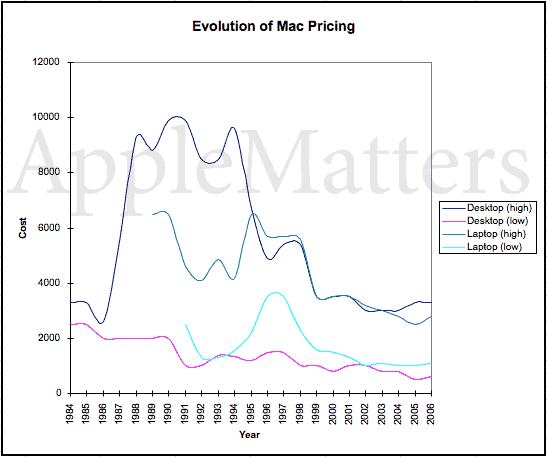Evolution of Mac Pricing or Surprise! Apple Cares!
Besides the one button mouse the biggest debate in the history of the Mac has been the high price. Actually, calling the matter a “debate” is a like saying the sun is shiny, some things just are. Which makes the introduction of the Mac Pro particularly interesting, the Mac Pro occupies what is traditionally Apple’s highest margin line and, in a turn more shocking than finding out Bruce Willis was dead the whole time, is priced much cheaper than a similar Dell.
With the worldview of many sufficiently rocked it would be wise to keep a few things in mind. The first is that Apple doesn’t price computers according to cost to build, the company just slaps whatever they think the market will bear on their computers and Mac towers hadn’t been selling well. The second thing to keep in mind is that Apple never sells loss leaders, you can rest assured that they are making plenty of scratch on the Mac Pro.
Still, for the first time, Mac Users can point to the Dell and say they can get a Mac cheaper without resorting to the usual argumentation. You know the deal, you add FireWire and virus programs to Dell, add in the cost of programs equivalent to the iLife Suite Etc. But, it makes one wonder, just where are Mac prices headed? There is no way to with certainty except that the trend will generally be down. Just how fast and how far? A look at the past is in order.
The first Mac, that woefully underpowered, but wonderfully cute machine cost $500 to produce. There was an internal battle over how much the Machine should sell for, Steve Jobs lobbied for a exorbitant markup of 400%. Sculley trumped Steve and decided the Mac needed a huge marketing push and bumped the price to $2500. That is the obvious starting point, the obvious ending point is the right here and now, with the Mini, Mac Pro, MacBook and MacBook Pro. If only there were a way to visually represent the information, some method wherein data could be illustrated as, let’s call them points, on a two dimensional surface… Oh yeah, a chart!

What we see is something interesting. The high end of the market, the bleeding edge, fluctuates wildly. The changes going up are larger and the drops down are more precipitous. Which shouldn’t really come as a surprise, the high end is aimed at pros, people who make money using their computer (and hobbyists who just have to live on the edge) and these are people compelled to pay for the fastest computer they can get. What is surprising is the pricing of the low end. Here we also see a decreasing cost but in a much more predictable fashion, without all the jumps and bumps. Consumers, particularly those with a bent for the cheapest model, are much more price sensitive than any other individual or business wanting a Mac. The fairly flat line at the low end shouldn’t be a surprise but it is when the company pricing the machines is Apple.
More interesting is the chart from 1997 onward, to wit:

What makes 1997 such a special year? It is the year that Steve Jobs regained power. Looking at this chart, we see that Steve, despite Apple’s reputation, started to push prices down aggressively. Nowhere is this more apparent than the big drop in the price of Apple’s cheapest laptop. Whether Steve saw the coming explosion of portable computing or just knew Apple was pricing their machines out of the market is unclear, what is clear is that the price of notebooks had to come down.
In the end, it doesn’t look like Apple is a company that blindly ignores price. Instead Apple is revealed to be a company very concerned about prices on the low end and recentl concerned about prices n the high end. This isn’t to say that Apple will or even wants to sell the cheapest machine possible, half of Apple’s appeal is the notion that what you’re getting is (modestly) more expensive, and thus better, than what the competition is pushing. That said, when it comes to price, Apple hears you, and they have for a long time.


Comments
If you were to factor in inflation (and I’m not sure that you _should_), then those peaks would be even higher!
You SHOULD use constant 2006 USD.
I considered using constant dollars but the rub is that that is tricky to do. Do you go by the increase in GDP? the change CPI? strictly by inflation? Or any of a number of different ways? Maybe average them altogether?
Each calculation of constant dollars has strengths and weaknesses, likely one is ideal for computers but it has been awhile since I took economics and to be honest I’m not sure which methodology would reveal the most relevant figures for this case.
That said, anyone who wants to perform the calculation themselves can email me for the data in .xls format and have a little party…
The first is that Apple doesn’t price computers according to cost to build, the company just slaps whatever they think the market will bear on their computers and Mac towers hadn’t been selling well.
This is true, btw, of almost every product made by every company in the country.
I’m definitely glad to see the prices coming down as I rely more and more on Macs for my work. The Macbook is now priced lower than my laptop I bought two 1/2 years ago, which was one of the cheapest I could find that did what I needed. The Macbook is still slightly underpowered, moreso than my laptop was at the time I bought it, but you didn’t even have the choice back then.